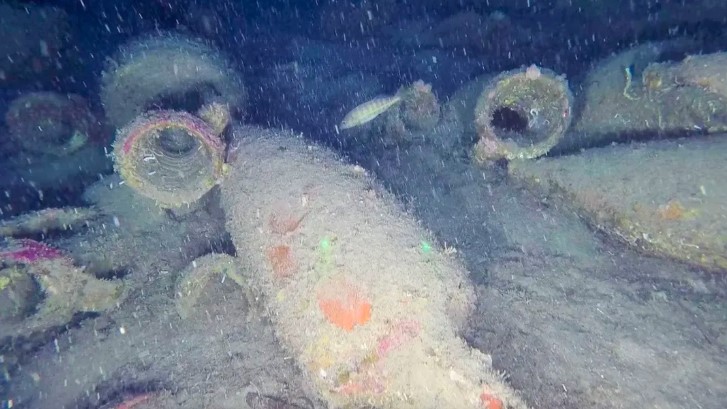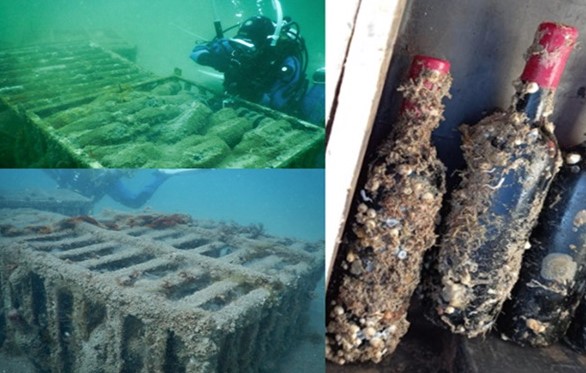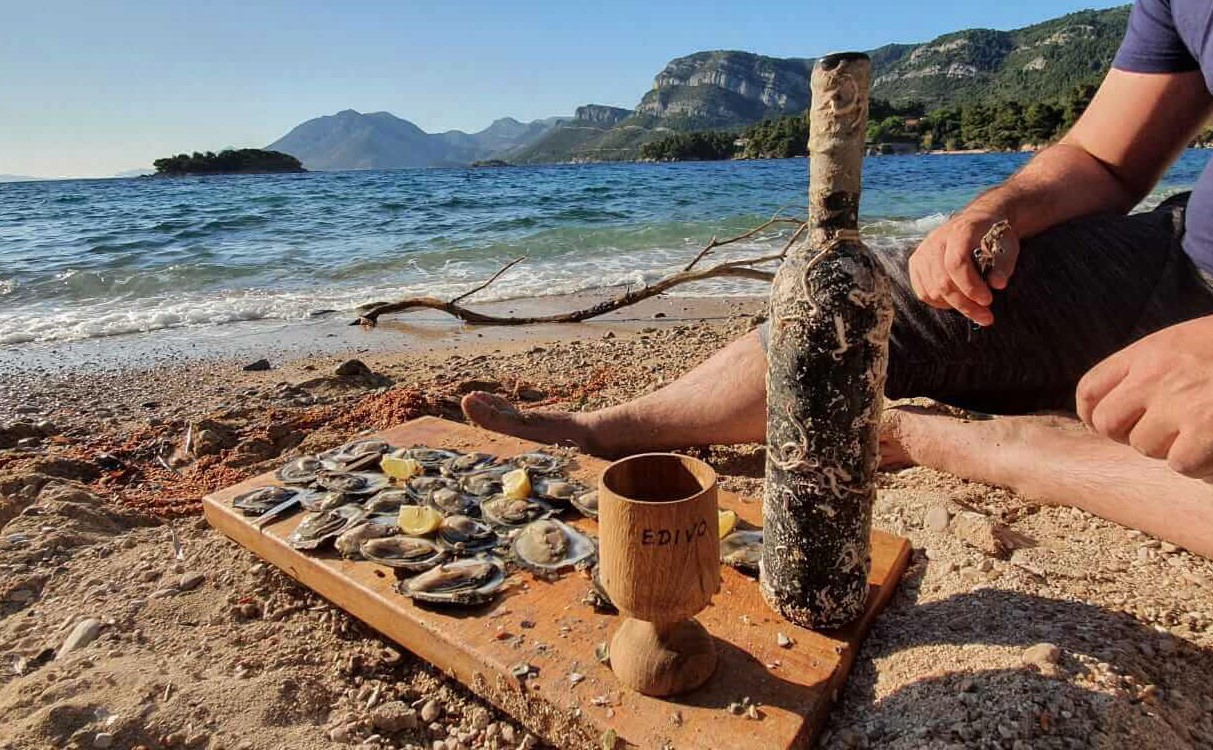Underwater wineries are actually a thing. Several producers around the world are leveraging their distinct locations to provide truly unique wine tasting experiences. Others are simply using nature’s depths to age wines and achieve pronounced, more integrated characteristics. Learn about these unexpected operations, some of the science behind the concept and how the practice came to be.
In the realm of winemaking, the quest for distinctive flavors and unique experiences has led to the innovative practice of underwater aging, a method that combines the adventurous spirit of diving with the ancient art of winemaking. Underwater wineries have emerged as a fascinating intersection of marine exploration and oenological excellence, offering Winetravelers the ultimate tasting experience that transcends traditional vineyard visits.
The Science and Allure of Underwater Aging
The concept of aging wine underwater is driven by the pursuit of enhancing wine’s character in ways not possible on land. This method has gained traction for several reasons. The constant cool temperatures found at the depths of the sea provide an ideal environment for aging, akin to nature’s own cellar. The absence of light and reduced oxygen levels help in preserving the wine’s quality while potentially speeding up the aging process.
Importantly, the gentle swaying motion of the water and fluctuating currents can significantly improve the wine’s maturation by subtly stirring the lees (dead yeast cells) and other sediments within the bottle. This action ensures that the yeast deposits and particulate matter, which settle at the bottom of the container after fermentation and during aging, are kept in suspension. The interaction between the wine and its sediments is crucial for developing a wine’s body and character, as the lees release mannoproteins and other compounds that enhance mouthfeel, add creaminess, and influence the overall flavor profile. Wines aged in this dynamic underwater environment exhibit a more integrated and nuanced flavor profile, with a complexity and depth that might not be as pronounced in wines aged under static conditions.
How Did Aging Wine Underwater Come to Be?
Underwater aging draws inspiration from discoveries of shipwreck wines, which were found to have aged remarkably well, sparking curiosity among vintners to experiment with deliberate submersion.
Baltic Sea Shipwreck Inspires Undersea Wine Aging Projects



The Baltic shipwreck found contained 19th-century bottles of several esteemed Champagne houses. The corks, still in exceptional condition, helped identify the producers included in the cargo. The likely trade route between France and Russia is featured above. Images via Jeandet et al./PNAS.
One notable find was in 2010 when divers in the Baltic Sea discovered 168 bottles of 170-year-old champagne from a sunken trade schooner off the coast of Finland, shedding light on 19th-century winemaking practices and the preservation potential of deep-sea conditions. The team of scientists, led by Philippe Jeandet, discovered that the sunken bottles of Champagne had elevated levels of sugar, in addition to other metallurgic compounds. “Today most champagnes contain low levels of sugar that are added at the end of the process,” (also known as dosage) according to Jeandet. “The Baltic wine we analyzed contained at least 140 grams of sugar per liter, as compared to about 6 to 8 grams per liter used today.” While this likely contributed to the preservation of the wine unintentionally, the wines were probably destined for Germany, whose inhabitants preferred sweeter wines at the time.
They also found above-average levels of copper, sodium, iron and chlorine. This led them to hypothesize that the wines were likely placed in both metal and wood vessels during the early production process. Additionally, “copper sulfate was often used for the control of disease in the vineyard, as opposed to fungicide containing organic compounds used today,” noted Jeandet. It was also not uncommon in the 19th-century to use both salt and chlorine during the production process to help stabilize wine. In conjunction with the low-light and oxygen levels found in the depths, these compounds may have furthered their age-ability.
The researches reported that after small samples were sipped and swirled for a time, the flavor profile revealed a canvas of “grilled, spicy, smoky, and leathery” notes. “It was incredible. I have never tasted such a wine in my life. The aroma stayed in my mouth for three or four hours after tasting it,” says Jeandet.
400-Year-Old Wreck Loaded with Wine Found in the Trave River
The discovery of “shipwreck wine” doesn’t stop in the Baltic. Archeologists recently uncovered high-quality wine from a 400-year-old shipwreck at the bottom of the Trave River in 2022, which flows into the Baltic Sea in Germany, believed to have sailed during the Age of Discovery.
Polish Shipwreck Found Containing 200-Year-Old Bottle of Booz
Researchers also discovered a 200-year-old bottle of alcohol, initially thought to be mineral water, from a shipwreck off the coast of Poland. Preliminary tests revealed it likely contained vodka or jenever, a gin-like spirit. Surprisingly, the contents were deemed drinkable, though not necessarily pleasant to the nose. Still, it highlights the remarkable preservation properties of underwater environments for organic compounds.
Ancient Shipwreck Carrying Wine Amphorae Found off the Coast of Sicily

While no longer taste-able, archaeologists uncovered an ancient Roman shipwreck off the coast of Palermo, Sicily from the second century B.C.E., packed with amphorae. These jars, typically used for transporting wine and olive oil, hint at the extensive trade networks of the ancient Mediterranean. The discovery, resting at a depth of about 302 feet, sheds light on the prolific wine trade of ancient Sicily.
These finds, from the Baltic Sea to the Mediterranean, really highlight the sea’s potential in preserving historical artifacts, offering invaluable insights into the culinary and commercial practices of past civilizations.
Underwater Wineries You Can Actually Visit
Producers with the location and financial means to do so, such as Veuve Clicquot, Gaia Winery, and Edivo Winery, have embarked on underwater aging projects, finding that these conditions can indeed impart unique qualities to the wine, such as increased complexity and a distinct minerality. This innovative approach not only challenges traditional aging techniques but also adds a layer of mystique to the wine, enhancing its appeal to connoisseurs and adventurers alike.
Edivo Vina, Croatia


Images courtesy Edivo Vina.
Drače 18 A Drače, Pelješac, 20246, Croatia
Located in the pristine waters of the Adriatic Sea, on the Pelješac Peninsula, near the town of Drače, Edivo Vina stands out as Croatia’s premier underwater winery. Here, visitors have the unique opportunity to dive down and explore the submerged wine cellar, where bottles and amphorae are aged beneath the waves. Edivo Vina specifically chooses Plavac Mali, a grape variety indigenous to the region, aging the wine first in French oak barrels before its sea submersion.






Images courtesy Edivo Vina.
The winery’s signature offering, the Navis Mysterium, is encased in clay and aged on the seafloor, emerging with a flavor profile enriched by the sea. After you’ve taken the dive, sip at one of their coastal tasting rooms with dramatic views and a full dining experience, or open a bottle right on the beach.
Crusoe Treasure, Spain
Areatza Hiribidea, s/n, 48630 Plentzia, Bizkaia, Spain

Found within the Bay of Plentzia, near Bilbao in Spain’s Basque Country, Crusoe Treasure lays claim to the title of Spain’s first underwater cellar. With a focus on scientific research and environmental stewardship, this winery ages its wines among the marine ecosystem, contributing to local biodiversity. The wines, subjected to the sea’s natural dynamics, exhibit unique characteristics, such as enhanced color intensity and a refined taste profile, which they claim is attributed to the underwater conditions.
Crusoe Treasure offers “underwater wine tourism experiences,” like their boat rides out to the underwater cellar, which includes tastings on board.
Gaia Winery, Greece



Images courtesy Gaia Wines and Volcano Dive Center.
Θέση Βραχειές, Έξω Γωνιά, Perivolia 847 00, Greece
Gaia Winery’s adventurous foray into underwater aging began with the submersion of their Assyrtiko wines (Thalassitis) in the Aegean Sea near Santorini, in collaboration with the Volcano Dive Center. Despite initial challenges, such as storms and pressure-related issues, the winery has successfully showcased the potential of marine aging to produce wines with preserved freshness and heightened aromatic complexity. You can visit their facilities on both Santorini and Nemea.
RELATED: 15 Less Touristy & Underrated Greek Islands To Visit
ALSO READ: Best Greek Islands to Visit for Different Types of Travelers: Which Island is Right for You?
Veuve Clicquot, France

Inspired by the 19th-century Baltic shipwreck we discussed earlier, where bottles of Veuve Clicquot from Madame Clicquote’s time were discovered in the cargo hold, Veuve Clicquot is undertaking a bold experiment dubbed “Cellar in the Sea.” They submerged a selection of their champagnes off the Baltic Sea’s coast.

Stored at depths where light and temperature fluctuations are minimal, these wines are part of a long-term study comparing their evolution to counterparts aged in traditional cellars, highlighting the potential for underwater aging to refine and enrich the champagne’s qualities.
While not currently open to the general public, in June last year (2023) Veuve Clicquot invited 28 guests and experienced divers the opportunity to visit and sample the resulting wines from the project. They were flown to the Åland Islands and then cruised to Silverskår. Lunch was provided aboard a two-masted schooner by chef Filip Gemzell of Michelin-starred ÄNG. They then traveled to Klobben for a comparative tasting of four cuvées selected for the experiment — Yellow Label Brut in 750 mL bottles and magnums, Vintage Rosé 2004, and Demi-Sec — plus the rare chance to taste the their traditional variations and underwater bottles side by side. Those with proper diving certifications were allowed visit the underwater cellar, called the Åland Vault, where the project’s wines are currently being held.
While we aren’t sure how frequently these kinds of experiences will be offered, you can reach out to Veuve Clicquot directly to see if similar experiences may be available. You can also contact them regarding private tours via email. Let us know in the comment section at the end of this article what you discover!
Wapisa & Wapisa Underwater Wines, Argentina

Camino 31 Parcela B 26 San Javier, R8501 Viedma, Río Negro, Argentina
Far from the European coasts, Wapisa Wines (Bodegas Tapiz) in Argentina is exploring the impact of the Atlantic Ocean’s characteristics on wine aging in collaboration with Comahue University. Situated in the Patagonia region, Wapisa’s initiative to submerge bottles near the Rio Negro offers a New World perspective on underwater wine aging, with preliminary results indicating promising differences in taste and complexity.
While still in its early stages, they plan to build on the project and not only offer these delicious wines to the public, but also offer wine tourism experiences to the local diving community and regional agencies.
It’s Just the Beginning
The convergence of winemaking and underwater exploration marks a captivating chapter in the story of wine, especially for us Winetravelers. As vintners around the globe dive into the depths to unlock new dimensions of flavor and texture, underwater wineries not only challenge our perceptions of aging but also offer an unprecedented way to experience wine. With each bottle retrieved from the sea, enthusiasts are invited to taste the essence of adventure, where each sip reveals the profound impact of nature’s own cellar. Be sure to follow along with Winetraveler as we reveal more adventurous winemaking practices and experiences for all to enjoy.
You are reading “Underwater Wineries Around the World: Unique Tasting Experiences and the Potential for Aging Wine Underwater” Back To Top
wineries near me for wine tasting, wines aged underwater, what wineries are aging wine in underwater cellars, can you visit an underwater winery: unique wineries to visit
If you enjoyed this guide, follow our Facebook page and consider joining our Facebook Group to interact with other Winetravelers and for wine travel inspiration around the world. Be sure to follow us on both X, TikTok and Instagram to stay up to date with our trending content.
